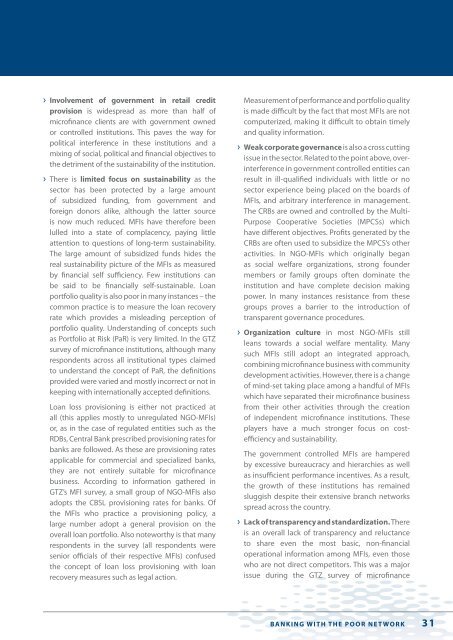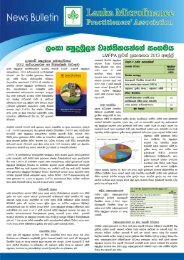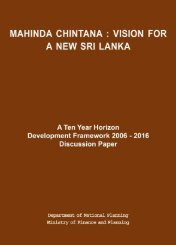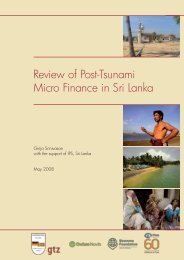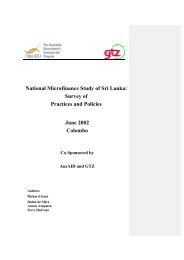Microfinance Industry Report SRI LANKA - Microfinance in Sri Lanka
Microfinance Industry Report SRI LANKA - Microfinance in Sri Lanka
Microfinance Industry Report SRI LANKA - Microfinance in Sri Lanka
You also want an ePaper? Increase the reach of your titles
YUMPU automatically turns print PDFs into web optimized ePapers that Google loves.
Involvement of government <strong>in</strong> retail credit<br />
provision is widespread as more than half of<br />
microf<strong>in</strong>ance clients are with government owned<br />
or controlled <strong>in</strong>stitutions. This paves the way for<br />
political <strong>in</strong>terference <strong>in</strong> these <strong>in</strong>stitutions and a<br />
mix<strong>in</strong>g of social, political and f<strong>in</strong>ancial objectives to<br />
the detriment of the susta<strong>in</strong>ability of the <strong>in</strong>stitution.<br />
> > There is limited focus on susta<strong>in</strong>ability as the<br />
sector has been protected by a large amount<br />
of subsidized fund<strong>in</strong>g, from government and<br />
foreign donors alike, although the latter source<br />
is now much reduced. MFIs have therefore been<br />
lulled <strong>in</strong>to a state of complacency, pay<strong>in</strong>g little<br />
attention to questions of long-term susta<strong>in</strong>ability.<br />
The large amount of subsidized funds hides the<br />
real susta<strong>in</strong>ability picture of the MFIs as measured<br />
by f<strong>in</strong>ancial self sufficiency. Few <strong>in</strong>stitutions can<br />
be said to be f<strong>in</strong>ancially self-susta<strong>in</strong>able. Loan<br />
portfolio quality is also poor <strong>in</strong> many <strong>in</strong>stances – the<br />
common practice is to measure the loan recovery<br />
rate which provides a mislead<strong>in</strong>g perception of<br />
portfolio quality. Understand<strong>in</strong>g of concepts such<br />
as Portfolio at Risk (PaR) is very limited. In the GTZ<br />
survey of microf<strong>in</strong>ance <strong>in</strong>stitutions, although many<br />
respondents across all <strong>in</strong>stitutional types claimed<br />
to understand the concept of PaR, the def<strong>in</strong>itions<br />
provided were varied and mostly <strong>in</strong>correct or not <strong>in</strong><br />
keep<strong>in</strong>g with <strong>in</strong>ternationally accepted def<strong>in</strong>itions.<br />
Loan loss provision<strong>in</strong>g is either not practiced at<br />
all (this applies mostly to unregulated NGO-MFIs)<br />
or, as <strong>in</strong> the case of regulated entities such as the<br />
RDBs, Central Bank prescribed provision<strong>in</strong>g rates for<br />
banks are followed. As these are provision<strong>in</strong>g rates<br />
applicable for commercial and specialized banks,<br />
they are not entirely suitable for microf<strong>in</strong>ance<br />
bus<strong>in</strong>ess. Accord<strong>in</strong>g to <strong>in</strong>formation gathered <strong>in</strong><br />
GTZ’s MFI survey, a small group of NGO-MFIs also<br />
adopts the CBSL provision<strong>in</strong>g rates for banks. Of<br />
the MFIs who practice a provision<strong>in</strong>g policy, a<br />
large number adopt a general provision on the<br />
overall loan portfolio. Also noteworthy is that many<br />
respondents <strong>in</strong> the survey (all respondents were<br />
senior officials of their respective MFIs) confused<br />
the concept of loan loss provision<strong>in</strong>g with loan<br />
recovery measures such as legal action.<br />
Measurement of performance and portfolio quality<br />
is made difficult by the fact that most MFIs are not<br />
computerized, mak<strong>in</strong>g it difficult to obta<strong>in</strong> timely<br />
and quality <strong>in</strong>formation.<br />
> > Weak corporate governance is also a cross cutt<strong>in</strong>g<br />
issue <strong>in</strong> the sector. Related to the po<strong>in</strong>t above, over<strong>in</strong>terference<br />
<strong>in</strong> government controlled entities can<br />
result <strong>in</strong> ill-qualified <strong>in</strong>dividuals with little or no<br />
sector experience be<strong>in</strong>g placed on the boards of<br />
MFIs, and arbitrary <strong>in</strong>terference <strong>in</strong> management.<br />
The CRBs are owned and controlled by the Multi-<br />
Purpose Cooperative Societies (MPCSs) which<br />
have different objectives. Profits generated by the<br />
CRBs are often used to subsidize the MPCS’s other<br />
activities. In NGO-MFIs which orig<strong>in</strong>ally began<br />
as social welfare organizations, strong founder<br />
members or family groups often dom<strong>in</strong>ate the<br />
<strong>in</strong>stitution and have complete decision mak<strong>in</strong>g<br />
power. In many <strong>in</strong>stances resistance from these<br />
groups proves a barrier to the <strong>in</strong>troduction of<br />
transparent governance procedures.<br />
> > Organization culture <strong>in</strong> most NGO-MFIs still<br />
leans towards a social welfare mentality. Many<br />
such MFIs still adopt an <strong>in</strong>tegrated approach,<br />
comb<strong>in</strong><strong>in</strong>g microf<strong>in</strong>ance bus<strong>in</strong>ess with community<br />
development activities. However, there is a change<br />
of m<strong>in</strong>d-set tak<strong>in</strong>g place among a handful of MFIs<br />
which have separated their microf<strong>in</strong>ance bus<strong>in</strong>ess<br />
from their other activities through the creation<br />
of <strong>in</strong>dependent microf<strong>in</strong>ance <strong>in</strong>stitutions. These<br />
players have a much stronger focus on costefficiency<br />
and susta<strong>in</strong>ability.<br />
The government controlled MFIs are hampered<br />
by excessive bureaucracy and hierarchies as well<br />
as <strong>in</strong>sufficient performance <strong>in</strong>centives. As a result,<br />
the growth of these <strong>in</strong>stitutions has rema<strong>in</strong>ed<br />
sluggish despite their extensive branch networks<br />
spread across the country.<br />
> > Lack of transparency and standardization. There<br />
is an overall lack of transparency and reluctance<br />
to share even the most basic, non-f<strong>in</strong>ancial<br />
operational <strong>in</strong>formation among MFIs, even those<br />
who are not direct competitors. This was a major<br />
issue dur<strong>in</strong>g the GTZ survey of microf<strong>in</strong>ance<br />
Bank<strong>in</strong>g With The Poor Network 31


